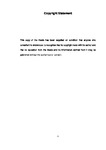CONTAINER SHIPPING RISK MANAGEMENT: A CASE STUDY OF TAIWAN CONTAINER SHIPPING INDUSTRY
| dc.contributor.supervisor | Song, Dong-Ping | |
| dc.contributor.author | Chang, Chia-Hsun | |
| dc.contributor.other | Plymouth Business School | en_US |
| dc.date.accessioned | 2013-08-05T10:09:33Z | |
| dc.date.available | 2013-08-05T10:09:33Z | |
| dc.date.issued | 2013 | |
| dc.identifier | 10262491 | en_US |
| dc.identifier.uri | http://hdl.handle.net/10026.1/1590 | |
| dc.description.abstract |
Whilst container shipping has become increasingly important over the past few decades due to its obvious advantages, container shipping companies have faced various risks from different sources in their operations. Systematic academic studies on this topic are few; and in light of this, this study aims to systematically explore and analyse the risks in container shipping operations and to examine the applicable risk mitigation strategies in a logistics perspective, including information flow, physical flow, and payment flow. This thesis uses Taiwan container shipping industry as a case study, and borrows four steps of risk management as the main method, which includes risk identification, risk analysis, risk mitigation strategies identification, and strategies evaluation. In order to ensure the analysis is inclusive and systematic, risk factors and risk mitigation strategies are identified through a related literature review and are validated through a set of interviews. Risk analysis is conducted through using questionnaires, and then through risk ranking, risk matrix, risk mapping, and P-I graph. Risk mitigation strategies are evaluated through classic AHP and fuzzy AHP analysis. A number of significant findings have been obtained. Firstly, 35 risk factors are identified and classified into three categories: risks associated with information flow, risks associated with physical flow, and risks associated with payment flow. After collecting and analysing the risk-factor survey, the results indicate that the risk associated with physical flow has the more significant impact on shipping companies’ operation. However, one risk factor associated with information flow, “shippers hiding cargo information”, has the most significant impact among the 35 risk factors. Secondly, 20 risk mitigation strategies are identified and classified into three categories: intra-organisational strategies, intra-channel strategies, and inter-channel strategies. After collecting the AHP survey and analysing through classic AHP and fuzzy AHP, the result indicates that “slot exchange, slot charter, joint fleet, ship charter with other container shipping companies” is the most important strategy. The main contributions of this thesis include: (1) based on the literature review, there have been no research on risk management in the context of container shipping operation from a broad logistics perspective, and this thesis is the first attempt to fill this research gap; (2) this thesis uses Taiwan shipping industry as a case study to apply the framework, which generates useful managerial insights; (3) the conceptual model of risk management developed in this thesis can be applied to container shipping operations in other countries and regions; (4) compared with several studies using secondary data, this thesis uses empirical data to conduct the risk analysis, and make the results more close to the reality situation in container shipping; (5) in terms of risk analysis, this thesis ranks the total 35 risk factors rather than only identify the most important one, this can be used to be generalised to the whole container shipping companies in Taiwan, or even to the whole world; (6) in terms of risk management, the previous studies usually analyse only the importance of strategies. However, this thesis analyses the results of AHP from three different angles: reducing financial loss, reducing reputation loss, and reducing safety and security incident related loss. This can provide different angles for the managers who are considering different aspects. | en_US |
| dc.language.iso | en | en_US |
| dc.publisher | University of Plymouth | en_US |
| dc.subject | Container Shipping | en_US |
| dc.subject | Risk Management | en_US |
| dc.subject | Case study | en_US |
| dc.subject | AHP Analysis | |
| dc.title | CONTAINER SHIPPING RISK MANAGEMENT: A CASE STUDY OF TAIWAN CONTAINER SHIPPING INDUSTRY | en_US |
| dc.type | Thesis | |
| plymouth.version | Full version | en_US |
| dc.identifier.doi | http://dx.doi.org/10.24382/4509 | |
| dc.identifier.doi | http://dx.doi.org/10.24382/4509 |
Files in this item
This item appears in the following Collection(s)
-
01 Research Theses Main Collection
Research Theses Main


